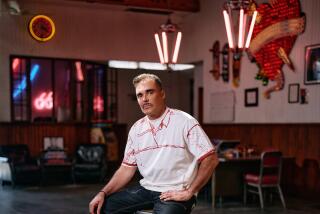Portraits by the Artist as a Young Man
It’s easy to become jaded by the wonders of the Internet.
The ability to send messages all over the world, do research on an astonishing range of topics and engage in debate on current events with scores of people I will never meet--all while sitting in front of my computer screen--has become part of everyday life.
Then I happened upon the photographs of Seydou Keita, and was reminded that the Internet can sometimes truly be a gift.
For more than 30 years, Keita was almost completely unknown outside his home city of Bamako, the capital of Mali. Born in 1923, he got his first camera in 1945 from an uncle who bought it in Senegal. He taught himself to use it.
“I really had a bad start,” he says in an interview reprinted on the World Wide Web site--https://zonezero.com/keita/. “People moved and I probably trembled myself. When printing, they all looked like skeletons.”
Four years later he bought a newer camera and set up shop as a portrait photographer. He preferred working outside in the daylight, and for his first backdrop he used his own bedcover.
It was a time of great change in Mali. Bamako was becoming a major city, and crowds gathered at Keita’s studio, especially on Saturdays. “Sometimes there were more than 100 people. . . . Even the first president of the republic came,” he remembers.
It is easy to see what attracted them. The portraits displayed are startling black and white images, both technically accomplished and evocative. “They have great dignity,” said Christraud M. Geary, who oversees photographic exhibitions at the National Museum of African Art in Washington. The museum, which is part of the Smithsonian Institution, will have a small group of Keita prints on display March 27-July 28.
They record a time of great change, when people were adjusting to city life and the growing influence of the West. Many people wanted to be photographed in Western attire or with props. For them, Keita kept a supply in his studio.
“He offered men three European-style suits, with shirts, ties, shoes and hats,” Geary writes in a brochure that will accompany the exhibition. “A wristwatch, fountain pens, plastic flowers, a radio and a telephone were among the symbols of modernity the patron could select.”
One of the most haunting of his images is of a young woman with her arm around a desktop radio as if it was a close friend. Another is of a man dressed in spectacular, traditional African garb and holding a Western-style briefcase.
Keita closed his studio in the early 1970s. “I stopped photographing when color photography took over,” he says. “People like it now, but machines are doing the work. Many people call themselves photographers nowadays, but they don’t know anything.”
He became a government worker and eventually retired. He still lives in Bamako, where a visiting French photographer saw his work and began spreading the word.
The Internet site where the Keita images can be found is “Zone-Zero,” started late last year by Pedro Meyer, a noted photographer in his own right, to show the work of lesser known people in the field.
* Cyburbia’s e-mail address is David.C[email protected].
More to Read
The biggest entertainment stories
Get our big stories about Hollywood, film, television, music, arts, culture and more right in your inbox as soon as they publish.
You may occasionally receive promotional content from the Los Angeles Times.











